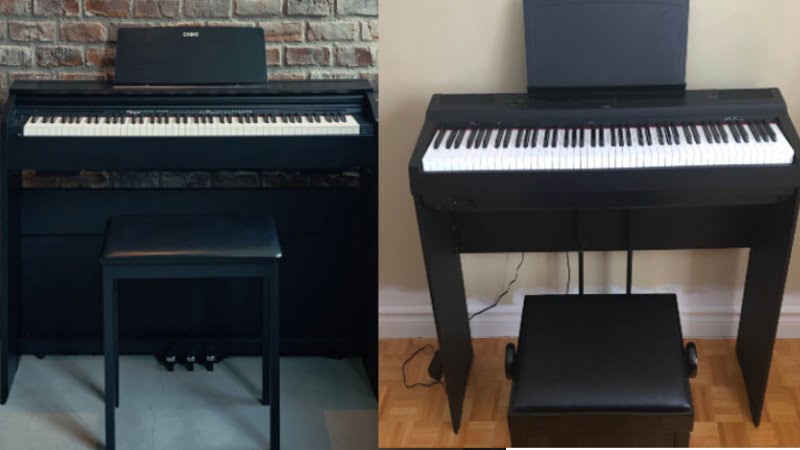Find out why the Casio PX-870 is a better overall investment in this Casio PX-870 vs Yamaha P-125 comparison.
The portable vs console digital piano debate is always a hot topic in musician’s circles. And there’s no better example of that than the Casio PX-870 vs Yamaha P-125 comparison.
They are in roughly the same price range, both come with a great set of different features, and would be a great choice for just about any pianist out there. But which one offers a better bang for the buck?
Well, after an in-depth comparison, I ended up choosing the Casio PX-870. While you say goodbye to bringing the piano around with you, the realistic feel and great piano features put it on top of the Yamaha P-125.
But if you really need a piano that you can bring around with you to lessons, jam sessions, rehearsals, and even gigs, you might be better off with the Yamaha P125.
Casio PX-870 vs Yamaha P-125: Comparison Chart

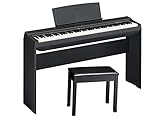


Last update on 2025-04-17 / Affiliate links / Images from Amazon Product Advertising API
Casio PX-870 vs Yamaha P-125: The Features
These are two very different pianos, which made this a pretty tough comparison. But I found that if I focused on the individual features, it was much easier to choose an objective winner. And after going through the most important features for any piano, I found that the Casio PX-870 won out with a score of 2-1.
With that said, the Yamaha P-125 put up a really good fight, and even stole the point in terms of tone. Keep reading to find out the details and learn the best pick for your needs!
Tone
The winner: Yamaha P-125
It’s hard to beat Yamaha digital pianos when it comes to tone. Yamaha is known for a great range of digital and acoustic instruments, and the tones of the Yamaha P-125 have an undeniable quality to them. And while the Casio PX-870, was pretty close behind for the entire comparison, it couldn’t beat the versatility and quality of the Yamaha P-125.
+Tone Generation
The Casio PX-870 uses the AiR Sound Source. This is a variation on the traditional sampling method for generating tones. The main difference here is that the AiR Sound Source uses 4-layered samples. That way, you get a much richer and fuller tone than a bunch of other pianos.
Compared to most pianos in the price range, the Casio PX-870 exceeds expectations. However, the Yamaha P-125 uses the Pure CF Sound Engine, which is one of the best on the market today.
The Yamaha P-125’s tones come from their line of CF Concert Grand Pianos. These are some of the most highly-coveted pianos in the world, and Yamaha made sure to use the best equipment to record the samples from the pianos.
The result? A set of highly realistic piano voices that is hard to beat. In fact, the Yamaha P-125 has a bunch of tones that can easily beat a lot of more expensive pianos on the market today.
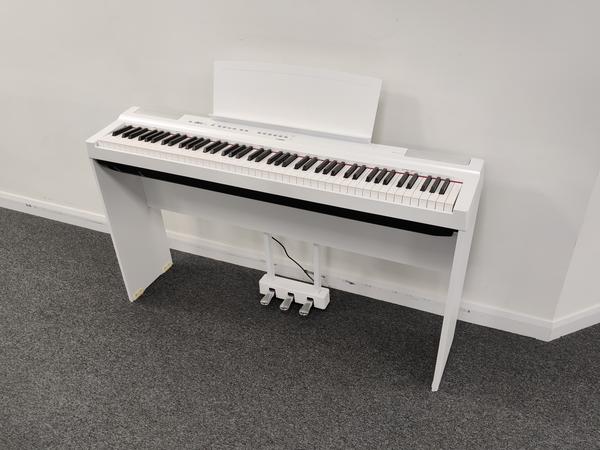
+Sound Library
Another reason the Yamaha P-125 won out in this category is the wider sound library. The Yamaha P-125 comes with 24 different tones. Granted, it isn’t that much more than the Casio PX-870’s 19 tones, but it still makes a big difference.
With that said, you have the same general tone categories with both pianos such as electric and acoustic pianos, strings, bass, and even organ voices. But the Yamaha P-125 comes with more options for organs, synth, and string voices, which is why it won out in this category.
If you’re looking for a versatile piano with many different voices, both of these options will suit your needs pretty well. However, the Yamaha P-125 has a slight edge as it carries more unique voices than the Casio PX-870.
Feel
The winner: Casio PX-870
Feel is a very important factor when choosing a digital piano. And after trying out both models, I found that the Casio PX-870 did a better job at replicating the feel of an acoustic piano. This is due to a great combination of hammer action and coated keys. The Yamaha P-125 had a pretty good hammer action system, but I was left largely let down by the key texture.
+Hammer Action
There’s no doubt in my mind that both of these pianos offer realistic hammer action. The Casio PX-870 uses the Scaled Hammer Action II system while the Yamaha uses the Graded Hammer Standard. Both of these hammer action systems result in heavier keys on the left side than the right side, just like on an acoustic piano.
However, I found that the Casio PX-870 had a slightly more realistic weight to the keys. The Yamaha P-125’s hammer action is pretty good. But considering the price point, it would have been nice if it featured the Yamaha GH3 system instead for more realism.
Pressing down on either of these pianos feels very realistic. However, the one complaint I have is that the keys don’t spring back as fast as I would have liked, particularly on the Yamaha P-125. Again, this would have easily been solved if the piano used the GH3 system instead.
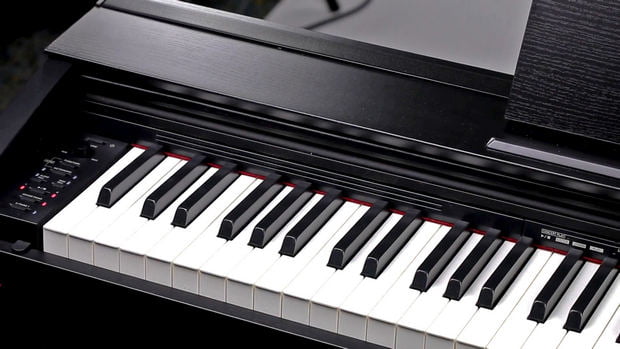
+Key Texture
While the Casio PX-870 had a slightly more realistic hammer action than the Yamaha P-125, the real reason I gave it the point for feel is the textured keys. Many manufacturers tend to overlook the importance of textured keys, so it’s a nice change that Casio PX-870 offered a fix.
The Yamaha P-125 has glossy plastic keys, which is something to expect in this price range. However, the Casio PX-870 offers a textured coating on both the black and white keys so it better resembles an acoustic piano.
If you’re a beginner, the key texture won’t matter as much as the difference is very subtle. However, the more you play an acoustic piano, the more you get used to the texture and the difference between an acoustic piano’s keys and the Yamaha P-125’s becomes glaring.
With that said, the Casio PX-870’s keys still don’t 100% feel like wooden piano keys. However, it does do a significantly better job than the Yamaha P-125, which is worth considering.
Piano Features
The winner: Casio PX-870
Up until this point, these two pianos were tied. But since the Casio PX-870 has better polyphony and comes with a wider range of effects, I awarded it the deciding point. The Yamaha P-125 still offers a great set of features, but it just isn’t as good as the PX-870.
+Polyphony
The Casio PX-870 has 256-note maximum polyphony while the Yamaha only has a 192-note maximum polyphony. This gives the Casio PX-870 a bit more versatility and better ability to play dense and wide chords even with the sustain pedal on.
However, keep in mind that the Casio PX-870 needs higher polyphony. Since the Casio uses multi-layered samples, it needs stronger computing power to process all the different tones at the same time.
In this day and age, polyphony isn’t as important since computing technology is cheaper and more accessible. But the numbers don’t lie and the Casio PX-870 definitely features better polyphony than the Yamaha P-125.
+Effects
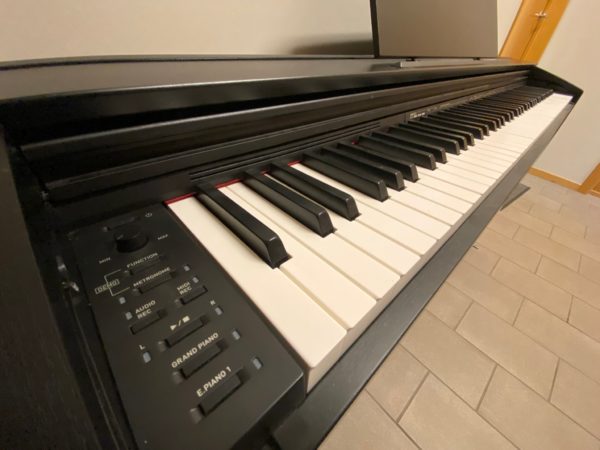
Both of these pianos come with a decent set of effects. On the Casio PX-870, you get reverb, chorus, and brilliance control. On the Yamaha P-125, you get reverb, sound boost, IAC, and damper resonance.
These are great features, and while the Yamaha P-125 has more effects, keep in mind that these are pretty passive effects. In fact, if you’re a beginner, it will be hard for you to hear the effects that damper resonance and IAC have on your tones.
The Casio PX-870 offers more active effects. So, the second you apply the effects you can hear what it does to your tone. The Yamaha’s effects are better suited for professional pianists who need to tweak those slight parameters, but beginners won’t find them too useful.
Casio PX-870 vs Yamaha P-125: The Similarities
These are two very different pianos. One is a portable option, the other one is designed to stay in one place or venue for a long time. However, that doesn’t mean that you can’t find any similarities between the two.
To start, they both feature a full keyboard. While this may not sound that important, you need to have a full range of notes to really learn the versatility of the piano. So, whether you’re a beginner, novice, or professional performer, you will enjoy the full range of notes on these pianos.
Additionally, both pianos come with a range of different playing modes. You can use split, lesson, and layering modes on both pianos. This allows you to use the pianos for classes or create new and unique tones and combinations that suit your playing style.
Both of the pianos are great options. However, the right one for you largely depends on your needs. I prefer the Casio PX-870 as it feels closer to an acoustic piano while still offering great tones. But if you need something you can bring with you to gigs and rehearsals, you might be better off with the Yamaha P-125.
Quick Rundown of the Casio PX-870
- The AiR engine provides highly-accurate grand piano sounds with seamless dynamics for a remarkably expressive and powerful performance
- The PX-870 features a variety of 19 instrument Tones, with the ability to layer and split them as needed. Touch Response - 3 sensitivity levels, Off
- With a generous 256 notes of polyphony, you can rest assured that even the most complex performances will sound perfectly natural
- The Tri-Sensor Scaled Hammer Action II keyboard has an incredible feel and captures the dynamics of a performance with unparalleled speed and accuracy
- The powerful 40-watt, 4-speaker system is designed to envelop the listener, audience and room with rich, detailed sound
Last update on 2025-04-17 / Affiliate links / Images from Amazon Product Advertising API
Quick Rundown of the Yamaha P-125
- Includes P125B digital piano, L125B furniture stand, BB1 wooden bench
- A fully weighted digital piano with 88 full sized piano style keys
- GHS weighted action is heavier in the low keys and lighter in the high keys, just like an acoustic piano
- The pure CF sound engine faithfully reproduces the tone of the acclaimed Yamaha 9' CFIIIS Concert Grand piano
- USB to host connectivity with MIDI and audio transfer means you only need 1 Cable to connect to your music making software
Last update on 2025-04-17 / Affiliate links / Images from Amazon Product Advertising API
Product Videos
Related Articles to Casio Px 870
- Casio PX-870 vs PX-850: Finding the Best Privia Piano
- Casio PX-870 vs AP-470: What Makes the AP-470 Different?
- Casio PX-870 vs Casio AP-650: Which Casio Should You Get?
- Casio PX-870 Vs AP-270: Which Console Digital Piano Should You Get?
- Casio PX-870 Vs Yamaha YDP-163: Which Digital Piano Is The Better Option?
- Casio PX-870 Vs Yamaha YDP-143: A Look At Two Top Digital Console Pianos
- Casio PX-870 Vs Kawai KDP-110: The Best Digital Pianos In The Price Range?
- Casio PX-870 Vs Roland F140R: Which Is The Better Piano?
- Casio PX-870 Vs Roland FP-30: Which Piano Should You Choose?
- Casio PX-870 Vs 860: A Battle Of Two Privia Pianos
- Casio PX-870 Vs Roland RP102: Which Is The Better Console Digital Piano For Beginners?
- Casio PX-870 Vs PX-780: Which Casio Model Is Best For You?
- Casio PX-870 Vs Yamaha YDP-164: Which Is The Better Choice For Beginners?
- Casio PX-870 Vs Yamaha YDP-144: Which Is The Better Console Digital Piano?
- Casio PX-770 Vs 870: Which Casio Console Digital Piano Is Better?
Related Articles to Yamaha P125
- Yamaha P150 vs P125: The Battle of the P-Series Models
- Yamaha P125 vs CLP 625: Can a Beginner’s Digital Piano Match the Clavinova?
- Yamaha P125 vs Roland FP 60: Which is the Better Investment?
- Yamaha P-121 vs P-125: Finding the Best Portable Yamaha Piano
- Yamaha P125 vs Korg LP 380: Which Piano Is Better for Your Needs?
- Yamaha P125 vs P85: Can the Outdated Digital Piano Beat the Newer One?
- Yamaha P125 vs DGX 670: Which Piano Comes Out on Top?
- Yamaha P125 vs Korg SP 280: Which is the Better Beginner’s Digital Piano?
- Yamaha P-255 vs P-125: Finding the Better Option for Beginners
- Yamaha P125 vs YDP S34 Comparison: Does the Portable P125 Hold Up Against a Console Digital Piano?
- Yamaha P125 Vs YDP 164: Should You Get A Console Or Digital Piano?
- Yamaha YDP 103 Vs P125: Should You Get a Portable or Console Digital Piano?
- Yamaha P125 Vs Kawai ES110 Comparison: Which Is The Best Portable Digital Piano
- Yamaha P125 vs Casio PX S1000: Which Digital Piano Is Worth Your Money?
- Alesis Recital Vs Yamaha P125: Which Is The Right Pick For You?
- Yamaha P45 VS P115: Which P-Series Newbie Gives You More Value for Money?
- Alesis Recital Pro vs Yamaha P125 Comparison: Which Is The Best Portable Digital Piano?
- Alesis Prestige Artist vs Yamaha P125 Comparison: Why the Yamaha P125 Is the Better Investment
- Yamaha P125 vs Casio PX-770 Review: Why the Yamaha P125 Beats Out the Casio Console Digital Piano
- Yamaha P125 vs DGX 660 Comparison: Can the P125 Hold Its Own Against the DGX 660?
- Yamaha P125 vs Roland FP-30X Review: Why the Roland FP-30X Comes Out On Top
- Yamaha P125 vs P515 Review: Why the Yamaha P515 Is the Better Investment
- Yamaha P115 vs P125 Review: Can the P125 Beat Out Its Predecessor?
- Yamaha P125 vs Roland FP30: A Close Battle Between Two Great Digital Pianos
- Yamaha P45 vs P125: Why the Yamaha P125 Is the Better Pick for Pianists
- Yamaha P71 vs P125: Why the Yamaha P125 Is the Better Investment
Reference:
- Casio PX-870: https://www.pianodreamers.com/casio-px870-review/
- Yamaha P-125: https://www.pianodreamers.com/yamaha-p125-review/
Lulacruza is an electronic folk duo operating at the junction of the hypermodern and the ancient. Our music weaves together hypnotic female singing, South American folk instruments and electronic processing, while channeling pulsating waves from the source of creation.
Lalucruza is also a community where you can connect with other music lovers to collaborate, exchange ideas and share knowledge. A platform for who wants to learns the basics of playing piano, guitar, drum masters’ technique, etc.. is the premise of our website.
